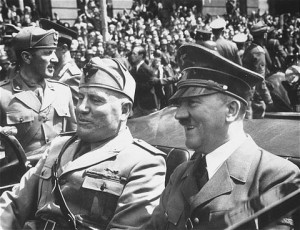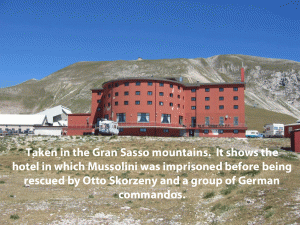Italian Tourist Industry Finds Mussolini Sites Popular
 They were neighbors and Central European allies, but the leaders of WWII Italy and Germany died within two days of each other. Benito Mussolini on April 28, 1945, Adolf Hitler on the 30th. Mussolini was shot while attempting to flee to neutral Switzerland as US, British, and communist partisans were overwhelming his once-strong fighting forces.
They were neighbors and Central European allies, but the leaders of WWII Italy and Germany died within two days of each other. Benito Mussolini on April 28, 1945, Adolf Hitler on the 30th. Mussolini was shot while attempting to flee to neutral Switzerland as US, British, and communist partisans were overwhelming his once-strong fighting forces.
When he finally made it to the Swiss border on April 28th, it was too late. He then joined some German soldiers who were escaping into Austria. Donning a Luftwaffe coat and helmet wasn’t enough, and he was shot by partisans, along with his friend Clara Petacci. Their bodies were put on display in Milan so that the public could find closure. His final period as Italy’s Il Duce had, after all, been full of dramatic episodes of escape and evasion, including his being sprung from captivity by German commandos in the San Grasso mountains, now a hotel (notice RVs in V. Marian photo below).
 Sure, the two Axis leaders became household obsessions across the globe, so it is understandable that tourists want to visit the biographical sites related to both men. Germany has always played down its involvement in the war, and sites relating to Hitler haven’t generally been saved or restored. Veterans and other tourists visiting Germany won’t find autobahn signs directing them to famous landmarks.
Sure, the two Axis leaders became household obsessions across the globe, so it is understandable that tourists want to visit the biographical sites related to both men. Germany has always played down its involvement in the war, and sites relating to Hitler haven’t generally been saved or restored. Veterans and other tourists visiting Germany won’t find autobahn signs directing them to famous landmarks.
In contrast, the Italian tourist industry has supported the demand for visiting places associated with the birth and final resting place of Mussolini and his family at Predappio. Remembering military history is, for some, at least as good as being channeled into “tourist traps” designed to sell t-shirts and other expensive souvenirs.
 They were neighbors and Central European allies, but the leaders of WWII Italy and Germany died within two days of each other. Benito Mussolini on April 28, 1945, Adolf Hitler on the 30th. Mussolini was shot while attempting to flee to neutral Switzerland as US, British, and communist partisans were overwhelming his once-strong fighting forces.
They were neighbors and Central European allies, but the leaders of WWII Italy and Germany died within two days of each other. Benito Mussolini on April 28, 1945, Adolf Hitler on the 30th. Mussolini was shot while attempting to flee to neutral Switzerland as US, British, and communist partisans were overwhelming his once-strong fighting forces. Sure, the two Axis leaders became household obsessions across the globe, so it is understandable that tourists want to visit the biographical sites related to both men. Germany has always played down its involvement in the war, and sites relating to Hitler haven’t generally been saved or restored. Veterans and other tourists visiting Germany won’t find autobahn signs directing them to famous landmarks.
Sure, the two Axis leaders became household obsessions across the globe, so it is understandable that tourists want to visit the biographical sites related to both men. Germany has always played down its involvement in the war, and sites relating to Hitler haven’t generally been saved or restored. Veterans and other tourists visiting Germany won’t find autobahn signs directing them to famous landmarks.